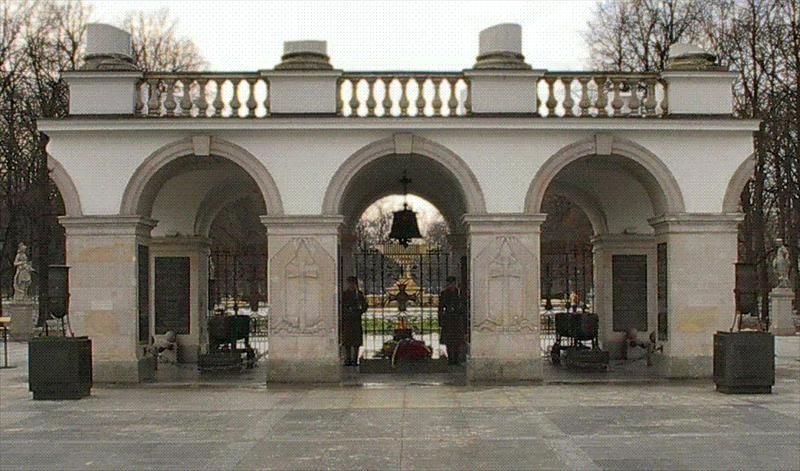
PL
Uwaga na kaczkę. Pilnuje skarbu, ale nie kesza.
Grób Nieznanego Żołnierza w Warszawie – grób-pomnik na placu marszalka Józefa Pilsudskiego w Warszawie. Idea warszawskiego Grobu Nieznanego Zolnierza jest uczczenie pamieci poleglych w walce o niepodleglosc. Grób zaliczany jest do narodowych imponderabiliów, symbolizujacych najwieksze poswiecenie.
Pomysl oddania holdu poleglym w walkach nieznanym zolnierzom narodzil sie bezposrednio po I wojnie swiatowej we Francji. Pierwszy na swiecie Grób Nieznanego Zolnierza powstal w Paryzu w 1920. Upamietnia on 1 500 tys zolnierzy poleglych w latach 1914–1918. Równolegle z Francja utworzono miejsca holdu bezimiennym zolnierzom w Wielkiej Brytanii.
W Polsce pierwsze inicjatywy stworzenia miejsca upamietniajacego poleglych pojawily sie w 1921. Grób Nieznanego Zolnierza w Warszawie powstal jednak ostatecznie w 1925 pod kolumnada Palacu Saskiego. 2 listopada tego roku do grobu zlozono zwloki bezimiennego zolnierza, sprowadzone podczas specjalnej ceremonii z Cmentarza Obronców Lwowa.
Pod koniec II wojny swiatowej grób ulegl powaznemu uszkodzeniu w wyniku wysadzenia w powietrze. Wkrótce zostal odbudowany i ponownie odsloniety w 1946. Obecnie stanowi trójarkadowy fragment ocalalej kolumnady Palacu Saskiego. W latach 1990–1991 wystrój grobu czesciowo zmieniono.
Przy Grobie Nieznanego Zolnierza w Warszawie plonie wieczny znicz i sluzbe pelni warta honorowa z Batalionu Reprezentacyjnego Wojska Polskiego, a w swieta panstwowe odbywa sie jej uroczysta zmiana z udzialem najwyzszych wladz panstwa.
EN
Please do not disturb a duck. This is a good idea, but this is only her house. She doesn't guarding a cache.
The Tomb of the Unknown Soldier is a monument in Warsaw, Poland, dedicated to the unknown soldiers who have given their lives for Poland. It is one of many such national tombs of unknowns that were erected after World War I.
In 1923, a group of unknown Varsovians placed, before Warsaw's Saxon Palace and the adjacent Saxon Garden, a stone tablet commemorating all the unknown Polish soldiers who had fallen in World War I and the subsequent Polish-Soviet War. This initiative was taken up by several Warsaw newspapers and by General Wladyslaw Sikorski. On April 4, 1925, the Polish Ministry of War selected a battlefield from which the ashes of an unknown soldier would be brought to Warsaw. Of some 40 battles, that for Lwów was chosen. In October 1925, at Lwów's Cemetery of the Defenders of Lwów, three coffins were exhumed: those of an unknown sergeant, corporal and private. The coffin that was to be transported to Warsaw was chosen by Jadwiga Zarugiewiczowa, mother of a soldier who had fallen at Zadwórze and whose body had never been found.
On November 2, 1925, the coffin was brought to Warsaw's St. John's Cathedral, where a Mass was held. Afterward eight recipients of the order of Virtuti Militari bore the coffin to its final resting place beneath the colonnade joining the two wings of the Saxon Palace. The coffin was buried along with 14 urns containing soil from as many battlegrounds, a Virtuti Militari medal, and an erection act. Since then, except under German occupation during World War II, an honor guard has continuously been held before the Tomb.
The Tomb was designed by the famous Polish sculptor, Stanislaw Kazimierz Ostrowski. It was located within the arcade that linked the two symmetric wings of the Saxon Palace, then the seat of the Polish Ministry of War. The central tablet was ringed by 5 eternal flames and 4 stone tablets bearing the names and dates of battles in which Polish soldiers had fought during World War I and the Polish-Soviet War (1919–21). Behind the Tomb were two steel gratings bearing emblems of Poland's two highest Polish military decorations — the Virtuti Militari and Cross of Valor.
During the 1939 invasion of Poland, the building was slightly damaged by German aerial bombing, but it was quickly rebuilt and seized by the German authorities. After the Warsaw Uprising, in December 1944, the palace was completely demolished by the Wehrmacht. Only part of the central colonnade, sheltering the Tomb, was preserved.
After the war, in late 1945, reconstruction began. Only a small part of the palace, containing the Tomb, was restored by Henryk Grunwald. On 8 May 1946 it was opened to the public. Soil from 24 additional battlegrounds was added to the urns, as well as more tablets with names of battles in which Poles had fought in World War II. However, the communist authorities erased all trace of the Polish-Soviet War of 1920, and only a few of the Polish Armed Forces' battles in the West were included. This was corrected in 1990, after Poland had regained its political autonomy.
Powodzenia - Good luck
== CONGRATS TO meteor2017 ON THE FTF!!!! ==